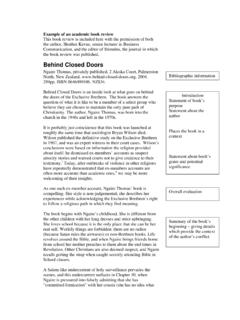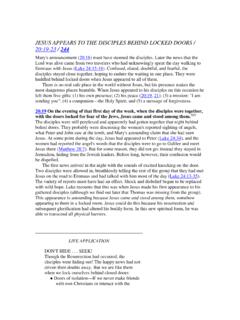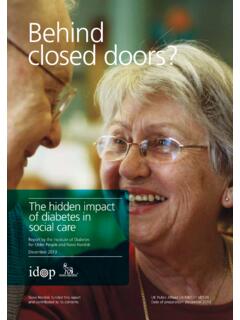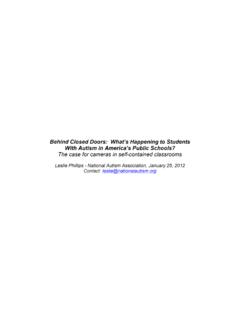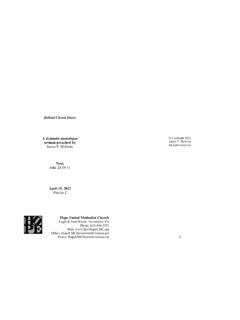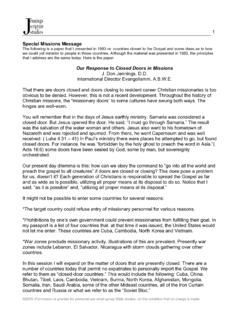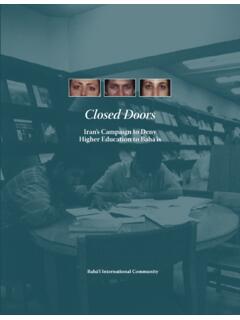Transcription of Behind The Closed Doors of Saudi Harems” Author: Hana Balaa
1 1 Behind The Closed Doors of Saudi Harems Author: Hana Balaa 2 Behind the Closed Doors of Saudi Harems Introduction I want the world to know that we are like other women, we have our dreams and aspirations but we just need a chance to express ourselves (20 yrs. old, Saudi female) For years, marketers have considered the Saudi female consumer segment as a taboo, especially as they are completely veiled and can not be approached or touched. This paper seeks to provide insights into female segments in Saudi Arabia in terms of their private lives, emotional needs and their evolution over time this, is based on years of in market experience and research conducted in Saudi Arabia. This paper also highlights the challenges we face in adopting different Qualitative approaches to help us better understand the Saudi female consumer behavior in terms of her needs and wants; at the conscious and unconscious level.
2 Hopefully, this paper will help marketers in areas such as brand positioning and communication development across various product sectors and female consumer segments. Some Facts In Million Source KSA 2004 Census Saudi Arabia is the most populated GCC state in all respects. The total population is around 22 million with nearly million Saudis and 6 million foreigners. Nearly half (50%) of the Saudi population are female. Saudi Arabia has a young population with over 50% being under the age of 25 years. Overall, the population in Saudi Arabia is growing by about 4% a year. A Glimpse of Reality Saudi Arabia is the most conservative country in the Arab World. In Saudi culture, a woman s primary role is to be a nurturing mother and a loving housewife. She is raised to believe that her place is at home taking care of her husband and children.
3 She is the love provider and care giver in the family. She is expected to give her full commitment to making a family home, a home in which she enjoys a pre-eminent role. Saudi Arabia adopted the Sharia interpretation of Islam in setting women s rights within its culture and society. However, the application of these rights has been driven by a high level of conservatism. Since Mecca is the first Islamic holy shrine that all Muslims aim to visit as part of fulfilling their Islamic convictions (the Hajj), Saudi Arabia felt the need to maintain a conservative Islamic image in order to resemble Islam in the Arab and neighboring world. 16,529 22,673 10,115 12,529 Total 6,144 1,872 4,271 All Expats 8,243 8,258 Saudis Total Female Male 1998 3 Being of a tribal community origin, males have a clearly defined and dominant role within the family which at its most basic level revolves around providing food for the table.
4 Men are the authority figure and the head of their household with a responsibility to support their family and ensure that they lead a decent life. Islam has given men the permission to take more than one wife at a time because in traditional times there was a higher ratio of women to men. But this was only technically allowed if men gave their wives equal rights and treated them justly. Marry women of your choice, two, three or four; but if you fear that you shall not be able to deal justly with them, then only one. That will be more suitable to prevent you from doing injustice (Qu ran 4:3) Even though polygamy is permitted, Islam realized that human nature is not capable of being just all the time and men will always have a preference for one wife over another. Hence polygamy was discouraged and restricted to those who have wisdom and self control.
5 You will never be able to deal justly between wives, however much you desire (to do so). But (if you have more than one wife) do not turn all together away (from one), leaving her in suspense. (Qu ran 4:129) Looking at today s reality, the application of this right is now taken for granted by men adding pressure on Saudi woman, in the sense that her husband can easily abandon or divorce her if she disobeys him; leaving her with no income to pursue her life. Her only refuge then would be to either going back to her parents or accept the status quo with her husband! According to Arab beliefs, the woman is a symbol of man s honor and it is the role of the male guardian to protect this honor. In Saudi Arabia this has been implemented by forcing the segregation of sexes which does not permit women mixing with men outside the (immediate) family.
6 This general rule applies to all aspects of social and public life such as education, restaurants, banking and public transportation to name a few. Women cannot travel, work or earn money without the approval of her male guardian whether it is her husband, father, brother or uncle. Adopting a conservative dress code is part of Islam. A woman should cover her hair and body so that other men are not attracted to her and cause her undue attention. However, on this front, Saudi culture takes an extreme level of conservatism where women are expected to be completely veiled, even the face, to ensure that they will not be seen by other unrelated men. Crucially from a marketing perspective, this rule has forced women to lead their own inner life that is separated from the public world. To the outsider - this has helped create a mystery surrounding Saudi women.
7 The diagram below illustrates the link between the different factors that have an impact on determining a woman s role and behavior within Saudi culture. Women Family Society Culture Religion Government 4 In Saudi Arabia, family ties are a priority; it is believed to be the central part of Saudi culture and women are at the core of the family. In order to ensure that women give their full commitment to their primary roles as mothers and housewives, they have traditionally been marginalized in terms of education, appearing in public, work and mobility. But at the same time, it was believed or rationalized that this behavior was adopted to support women in order to give them the respect they deserve. The dignity and value of being a wife and a mother should not be underestimated. A woman s place is her home and her home is her kingdom where she is the Queen who is treated with respect and dignity.
8 (50 yr. old, Saudi female) In the past women received little education; they were not permitted to go to school thus forcing them stay at home to fulfill their duties. This changed with the realisation that in order for women to raise future generations they should be educated. However, female education was delivered under religious doctrine. The aim was to ensure that their education did not deviate from the original purpose which was to make women good wives and mothers, and to prepare them for acceptable jobs such as teaching and nursing that were believed to suit their nature and local cultural traditions. However, with education came knowledge that led to a better awareness of the outside world. This has impacted and encouraged some women to re-evaluate their role within the family and society. They felt that they were cut off from the outer world and were restricted and forbidden from expressing themselves and having a personal identity.
9 Now, they want to take part in the man s world and to be heard and considered in all aspects of life. Joining the work force in female related fields has been a first step for them in gaining a semblance of independence. "With the different educational opportunities and universities that are emerging here, women have become more ambitious than their mothers and grandmothers. With education we are more knowledgeable, aware of different aspects that all help us in making the right decisions in life and choosing our own future" (21 yr. old, Saudi female) "With education, Saudi women are open to many opportunities and their interests in politics and society increases which encourages us to take part in different aspects of life" (21 yr. old, Saudi female) Changes Around the World Over the last few years the world has undergone major developments in terms of technology and communication.
10 To keep up with these developments, Saudi Arabia has felt the need to undertake some internal changes in order to join the World Trade Organization. Saudi Arabia is passing through an unprecedented era of transformation. The upheaval in social and economic changes that consumers have experienced and lived through over the last generation have been profound and unique; they are forcing Saudis, and its consumers, to look well beyond traditional boundaries, and to join the rest of the world and take part in the globalization movement. Some of the major changes implemented by the government have focused on re-evaluating women s situation and role within Saudi culture. Issuing a personal identity card to females was one of the first building stones. (In the past, the husband/ male relative held the family identity card). 5 Internal pressures are also playing a role in driving these changes forward.
